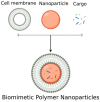Engineering Extracellular Vesicles as Nanotherapeutics for Regenerative Medicine
- PMID: 31905611
- PMCID: PMC7023093
- DOI: 10.3390/biom10010048
Engineering Extracellular Vesicles as Nanotherapeutics for Regenerative Medicine
Abstract
Long thought of to be vesicles that primarily recycled waste biomolecules from cells, extracellular vesicles (EVs) have now emerged as a new class of nanotherapeutics for regenerative medicine. Recent studies have proven their potential as mediators of cell proliferation, immunomodulation, extracellular matrix organization and angiogenesis, and are currently being used as treatments for a variety of diseases and injuries. They are now being used in combination with a variety of more traditional biomaterials and tissue engineering strategies to stimulate tissue repair and wound healing. However, the clinical translation of EVs has been greatly slowed due to difficulties in EV isolation and purification, as well as their limited yields and functional heterogeneity. Thus, a field of EV engineering has emerged in order to augment the natural properties of EVs and to recapitulate their function in semi-synthetic and synthetic EVs. Here, we have reviewed current technologies and techniques in this growing field of EV engineering while highlighting possible future applications for regenerative medicine.
Keywords: biomaterials; extracellular vesicles; regenerative medicine; stem cells.
Conflict of interest statement
The authors declare no conflict of interest.
Figures




Similar articles
-
Extracellular vesicles as bioactive nanotherapeutics: An emerging paradigm for regenerative medicine.Theranostics. 2022 Jun 21;12(11):4879-4903. doi: 10.7150/thno.72812. eCollection 2022. Theranostics. 2022. PMID: 35836815 Free PMC article. Review.
-
The Emerging Potential of Extracellular Vesicles in Cell-Free Tissue Engineering and Regenerative Medicine.Tissue Eng Part B Rev. 2021 Oct;27(5):530-538. doi: 10.1089/ten.TEB.2020.0222. Epub 2020 Dec 3. Tissue Eng Part B Rev. 2021. PMID: 33126845 Review.
-
Extracellular vesicles for tissue repair and regeneration: Evidence, challenges and opportunities.Adv Drug Deliv Rev. 2021 Aug;175:113775. doi: 10.1016/j.addr.2021.04.013. Epub 2021 Apr 17. Adv Drug Deliv Rev. 2021. PMID: 33872693 Review.
-
Extracellular Vesicles from Urine-Derived Stem Cell for Tissue Engineering and Regenerative Medicine.Tissue Eng Part B Rev. 2024 Apr;30(2):176-197. doi: 10.1089/ten.TEB.2023.0100. Epub 2023 Sep 22. Tissue Eng Part B Rev. 2024. PMID: 37603497 Review.
-
Functional Extracellular Vesicles for Regenerative Medicine.Small. 2022 Sep;18(36):e2106569. doi: 10.1002/smll.202106569. Epub 2022 Mar 23. Small. 2022. PMID: 35322545 Review.
Cited by
-
Exosomes and Biomaterials: In Search of a New Therapeutic Strategy for Multiple Sclerosis.Life (Basel). 2022 Sep 11;12(9):1417. doi: 10.3390/life12091417. Life (Basel). 2022. PMID: 36143453 Free PMC article. Review.
-
Current Knowledge and Future Perspectives of Exosomes as Nanocarriers in Diagnosis and Treatment of Diseases.Int J Nanomedicine. 2023 Aug 21;18:4751-4778. doi: 10.2147/IJN.S417422. eCollection 2023. Int J Nanomedicine. 2023. PMID: 37635911 Free PMC article. Review.
-
Engineered small extracellular vesicle-mediated NOX4 siRNA delivery for targeted therapy of cardiac hypertrophy.J Extracell Vesicles. 2023 Oct;12(10):e12371. doi: 10.1002/jev2.12371. J Extracell Vesicles. 2023. PMID: 37795828 Free PMC article.
-
Present and Future of Bronchopulmonary Dysplasia.J Clin Med. 2020 May 20;9(5):1539. doi: 10.3390/jcm9051539. J Clin Med. 2020. PMID: 32443685 Free PMC article. Review.
-
Perilla-Leaf-Derived Extracellular Vesicles Selectively Inhibit Breast Cancer Cell Proliferation and Invasion.Int J Mol Sci. 2023 Oct 26;24(21):15633. doi: 10.3390/ijms242115633. Int J Mol Sci. 2023. PMID: 37958616 Free PMC article.

